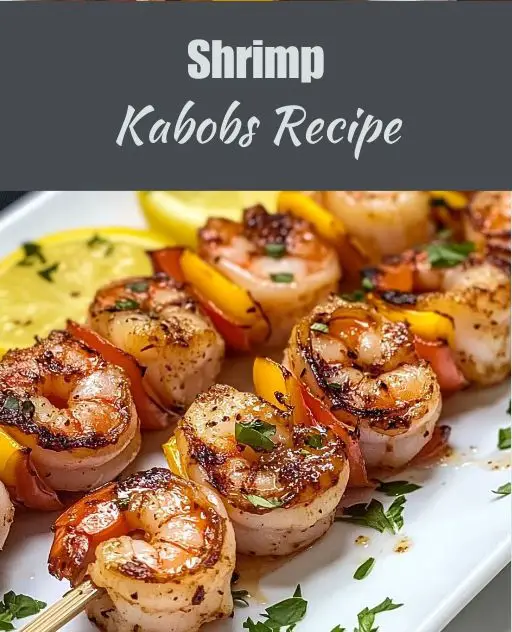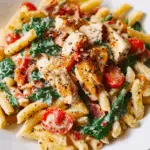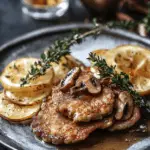Shrimp kabobs Recipe are a vibrant, protein-packed dish that brings together succulent seafood and crisp summer vegetables. A quick lemon-garlic marinade infuses the shrimp with bright Mediterranean flavor, while the peppers, zucchini, and red onion caramelize to a tender-crisp finish on the grill. Light yet satisfying, these skewers work just as well for easy weeknight dinners as they do for casual backyard gatherings or meal-prep lunches.
Ingredients
-
1 lb (450 g) large shrimp, peeled and deveined
-
1 red bell pepper, cut into 1-inch pieces
-
1 yellow bell pepper, cut into 1-inch pieces
-
1 zucchini, sliced into ½-inch rounds
-
1 red onion, cut into wedges
-
2 Tbsp olive oil
-
2 Tbsp lemon juice
-
3 cloves garlic, minced
-
1 tsp dried oregano
-
½ tsp paprika
-
Salt and freshly ground black pepper, to taste
-
Wooden or metal skewers
Shrimp Kabobs Recipe
Directions
-
Make the marinade – In a large bowl, whisk together olive oil, lemon juice, garlic, oregano, paprika, salt, and pepper.
-
Marinate the shrimp – Add shrimp to the bowl, turning to coat. Cover and chill for 15–30 minutes. (If using wooden skewers, soak them in water for at least 30 minutes to prevent burning.)
-
Assemble the kabobs – Thread marinated shrimp, bell peppers, zucchini, and red onion onto skewers, alternating for a colorful look.
-
Preheat the grill – Heat grill to medium-high and lightly oil the grates.
-
Grill – Cook kabobs 2–3 minutes per side, just until shrimp turn opaque and vegetables are tender-crisp.
-
Serve – Remove from grill and enjoy immediately. Pair with rice, couscous, or a crisp salad, and add garlic aioli, tzatziki, or an extra squeeze of lemon if desired.
Nutrients (per serving, ¼ of recipe)
-
Calories: ≈ 220 kcal
-
Protein: ≈ 25 g
-
Fat: ≈ 10 g
-
Carbohydrates: ≈ 8 g
-
Fiber: ≈ 2 g
-
Sugar: ≈ 4 g
Why Shrimp Kabobs Recipe Deserve a Spot on Your Table
Grilled shrimp kabobs capture everything we crave in warm-weather cooking: speed, simplicity, and lively flavor. The shrimp’s quick cooking time means dinner is ready in minutes, while the alternating peppers, zucchini, and red onion transform into smoky-sweet accents that make each bite pop. By threading seafood and vegetables onto the same skewer, you create an all-in-one entrée that feels celebratory yet is effortless enough for an ordinary Tuesday. Better still, these kabobs deliver lean protein, beneficial omega-3 fatty acids, and a rainbow of produce—an equation that satisfies both taste buds and nutrition goals.
Flavor Profile and Marinade Magic
At the heart of this dish is a zesty Mediterranean-inspired marinade. A foundation of extra-virgin olive oil and bright lemon juice carries minced garlic, earthy oregano, and a dusting of paprika into every crevice of the shrimp. Thirty minutes of marinating time is enough for the citrus to tenderize the seafood while the spices deepen, but if your schedule is tighter, even a 15-minute soak will heighten the final flavor. Because vegetables absorb seasoning more slowly, the quick bath you give the shrimp lets the produce retain its natural sweetness, balancing the assertive citrus-garlic notes of the shellfish.
Choosing the Best Shrimp
Fresh, raw shrimp are ideal, but frozen varieties often rival, or even surpass, “fresh” shrimp that have already been thawed behind the seafood counter. Look for large (31/40 count per pound) or extra-large (26/30 count per pound) shrimp; they stay juicy over direct heat and are sturdy enough to skewer without tearing. Opt for peeled and deveined tails if convenience is paramount, or choose shell-on if you don’t mind a little hands-on prep—the shells add an extra layer of flavor. Wild-caught shrimp generally boast cleaner flavor and firmer texture, while responsibly farmed options may offer sustainable certification. Either way, translucent flesh and a mild sea scent signal quality.
Skewers and Grilling Gear
Metal skewers excel at heat conduction, helping shrimp cook slightly from the inside as well as the surface. They’re reusable, splinter-free, and don’t need soaking. If you prefer wooden skewers, submerge them in water for at least 30 minutes to thwart flare-ups. A well-oiled grill grate is equally important; a neutral-oil–soaked paper towel gripped with tongs does the job. Whether you use gas, charcoal, or a stovetop grill pan, aim for medium-high heat—the sweet spot that sears the marinade’s olive oil and herbs into a light crust while keeping the interior tender.
Smart Prep and Time-Saving Tips
-
Batch prep on the weekend. Peel and devein a couple of pounds of shrimp at once; freeze half in resealable bags with marinade to streamline weeknight meals.
-
Uniform cuts matter. Slice peppers and zucchini into similar sizes so the skewers grill evenly. Thicker onion wedges caramelize without disintegrating.
-
One-bowl marinade method. Mix the liquid, toss in shrimp, cover, and chill. When it’s skewer time, add the vegetables directly to the same bowl—no extra dishwashing required.
-
Indoor option. A stovetop cast-iron grill pan or broiler works in a pinch; place the rack close to the heat source and flip halfway for char-kissed edges.
Health Benefits Beyond the Plate
Grilled seafood is widely recognized for supporting heart health thanks to its unsaturated fats and modest calorie count. Shrimp supplies about 25 grams of protein per four-ounce serving while staying under 120 calories. Paired with fiber-rich bell peppers and phytonutrient-laden zucchini, the kabobs become a low-carb powerhouse. The lemon-garlic marinade contributes vitamin C, antioxidants, and anti-inflammatory compounds that support immune defense. Choosing olive oil adds monounsaturated fats shown to aid cholesterol management. Together, these elements create a dish that feels indulgent but aligns beautifully with balanced-eating goals.
Creative Variations to Keep Things Fresh
-
Tropical Twist – Swap lemon for lime, oregano for cilantro, and add diced pineapple between shrimp for a sweet-savory contrast reminiscent of Hawaiian cuisine.
-
Spicy Cajun – Replace paprika with Cajun seasoning, then finish grilled skewers with a squeeze of charred citrus and chopped parsley.
-
Greek-Inspired – Thread cubes of halloumi cheese between the veggies, marinate with extra oregano and a pinch of dill, and serve over orzo tossed with olives and tomatoes.
-
Teriyaki Sesame – Glaze finished kabobs with a soy-ginger reduction, sprinkle with toasted sesame seeds, and serve atop brown rice for an Asian-inspired presentation.
-
Low-FODMAP Option – Omit garlic, use garlic-infused oil, and trade red onion for green onion tops to create a gut-friendly version without sacrificing depth of flavor.
Perfect Pairings and Serving Ideas
While kabobs alone can headline a meal, thoughtful sides round out the experience. A chilled quinoa tabbouleh echoes the Mediterranean notes and provides a light, herby counterpoint. Grilled corn on the cob brushed with herb butter mirrors the charred sweetness of the vegetables. For something heartier, lemon-parsley couscous or coconut-lime jasmine rice soak up stray marinade juices. If you crave crunch, serve the skewers over mixed greens scattered with feta and cherry tomatoes. Sauvignon Blanc, with its citrusy acidity, or a crisp pilsner also accentuate the shrimp’s brightness.
Leftovers, Storage, and Meal Prep
Cooked shrimp kabobs hold up well in the refrigerator for up to three days. Slide the shrimp and vegetables off their skewers into an airtight container to save space. Reheat gently in a hot skillet for two minutes or enjoy them cold over a salad. For freezer meal prep, freeze marinated raw shrimp (without vegetables) in a flat layer; thaw overnight, skewer with fresh produce, and grill. This approach preserves shrimp texture while avoiding mushy vegetables.
Frequently Asked Questions
-
Can I bake shrimp kabobs instead of grilling?
Yes—arrange skewers on a foil-lined baking sheet, broil on high, and turn once until shrimp turn opaque. The char won’t be as pronounced, but the flavor remains vibrant. -
Is it safe to marinate shrimp overnight?
Because acidic marinades can toughen delicate proteins, keep marinating time under two hours. Longer soaks are unnecessary and may affect texture. -
How do I prevent rubbery shrimp?
High heat and short cooking times are key. Pull the kabobs off the grill the moment shrimp turn pink and opaque; carryover heat will finish them perfectly. -
What if I want more heat?
Add a pinch of red-pepper flakes or a splash of hot sauce to the marinade, or serve with a spicy yogurt sauce on the side.
Sustainability Notes
If eco-friendliness is a priority, look for shrimp bearing certification labels such as MSC (Marine Stewardship Council) for wild-caught or ASC (Aquaculture Stewardship Council) for responsibly farmed. Choosing suppliers committed to minimizing bycatch and protecting coastal ecosystems ensures your delicious meal also supports healthier oceans.
Conclusion
Shrimp kabobs embody the best of casual outdoor dining: minimal prep, maximal reward, and flavors that straddle the line between bright summer freshness and smoky char. Whether you stick to the classic lemon-garlic profile or branch into global seasonings, the core technique stays the same—skewer, grill, and savor. Their nutritional advantages, adaptability to diverse palates, and ability to scale for gatherings make them a timeless staple for anyone seeking wholesome, crowd-pleasing fare. Fire up the grill, gather your favorite vegetables, and let these kabobs prove that a quick recipe can still taste—and look—spectacular.







